Optimal Design and Mathematical Modeling of Hybrid Solar PV–Biogas Generator with Energy Storage Power Generation System in Multi-Objective Function Cases
Abstract
1. Introduction
1.1. Background Justification and Motivations
1.2. Related Works
1.3. Contribution and Organization of the Paper
- To examine the impact of various inputs of financial, reliability, CO2 emissions parameters, and sensitivity analysis is performed on the optimized hybrid system components;
- Uncertainties in providing load demand in grid-connected systems are correctly addressed by a hybrid solar PV–biogas system with a SMES-PHES energy storage system based on an energy management strategy;
- Optimal sizing of grid-connected hybrid solar PV–biogas with SMES-PHES energy storage systems are depending on three objective functions such as NPC, LPSP, and CO2 emissions by utilizing metaheuristic optimization techniques;
- Comparing the optimization outcomes of the three solutions mentioned in each Pareto front. These are the points of economical, compromised, reliable, or environmental proportionality;
- Establishing a mathematical model for each system component in order to discover the best compromise option in terms of cost, reliability, and environmental impact;
- In terms of global solution capture and convergence time, these optimization findings verified the NSWOA algorithm is superior to the other metaheuristic optimization techniques.
2. Over View of Study Area and Existing System
3. Methodology
4. Hybrid System Configuration and Descriptions
4.1. Mathematical Modeling of Hybrid System
4.1.1. Solar Energy Conversion System Modeling
4.1.2. Biogas Generator System Modeling
4.1.3. Pumped Hydro Energy Storage System Modeling
- a.
- Generating Mode (): It suggests that the demand exceeds the PV system’s electricity generation. In this situation, the energy needed must be available from the storage system. How much power the PHES can generate depends on the volume of water in the upper reservoir and the turbines’ output power. The upper reservoir’s ability to hold enough water will allow it to meet the loads’ energy needs. In any other case, the storage system will attempt to function. In generation mode, the equation of the PHES system is represented as [47,48,49,50]:
- b.
- Pumping Mode: The proposed system then has excess power. The PHES process will pump until the upper reservoir is filled if the upper water tank is not yet full. The level of water in the reservoir, the amount of excess energy, and the maximum power of the PHES in pumping mode all affect how much water is pumped.
4.1.4. SMES Energy Storage System Modeling
- a.
- Charging mode: When the hybrid system power exceeds the load demand (i.e., ), this mode of operation happens.
- b.
- Discharging mode: When the load demand is higher than the hybrid system power (i.e., ), this mode of operation happens.
4.1.5. Inverter Energy Conversion System Modeling
4.2. Proposed System Operational Procedure and Power Management Strategy
- Mode I ( > ): In this mode, the available solar PV output exceeds the load demand, and energy storage systems (i.e., SMES and PHES) can absorb the extra power. The PV runs at MPP, while the SMES keeps the common DC bus voltage at its nominal value;
- Mode II ( < and ): The load demand cannot be satisfied in this mode by solar PV power. Therefore, energy storage system (i.e., SMES and PHES) discharges to meet the extra load. SMES energy storage system provides for transition periods;
- Mode III ( > ): If the amount of solar PV power available is more than the amount of power needed and the energy storage systems (SMES and PHES) are full, the extra power is sent to the national grid through feed-in-tariff agreements;
- Mode IV ( = 0): Solar PV power is not available on cloudy days or at night. In this mode, the PV is not connected, and the connected load demand is met by the energy storage systems (i.e., SMES and PHES). Whenever < and energy storage s ystem (i.e., SMES and PHES) is not able to meet the connected loads, then the biogas generator is on and provides power to unmeet connected loads;
- Mode V (): If the hybrid system is not capable to supply the connected load, then the deficit power is taken from the interconnected national grid through purchasing agreement.
5. Evaluation Parameter Modeling
5.1. Economic Modelling
5.2. Reliability Indicators
5.3. Environmental Indicators
6. Formulation of Optimization Problem
6.1. Objective Functions
6.2. Constraints
6.3. Optimization Techniques
7. Result and Discussion
7.1. Optimization Applications on Optimal Sizing of HRES Components
7.2. Result Evaluation of Economical, Reliability, and Carbon Emission Parameters
7.3. Analysis and Applications of HRES Optimal Solutions
8. Conclusions
Author Contributions
Funding
Data Availability Statement
Acknowledgments
Conflicts of Interest
Abbreviation and Symbols
| Exchange Power | |
| Charging Efficiency | |
| Discharging Efficiency | |
| Consumed Power for Pumping | |
| Consumed Energy for Pumping | |
| Inverter Output Power | |
| Number of PV Panels | |
| Inverter Efficiency | |
| Derating Factor of PV panel | |
| Maximum Reservoir Capacity | |
| Discharging Water Flow Rate | |
| Charging Water Flow Rate | |
| Pump Efficiency | |
| Exchange Rating Power | |
| Solar Panel Rated Power | |
| Exchange Energy | |
| Minimum Exchange Energy | |
| Maximum Exchange Energy | |
| Annualized Cost of PV Panel | |
| Annualized Cost of Biogas | |
| Annualized Cost of Inverter | |
| Annualized Cost of SMES | |
| Power Difference between Source and Demand | |
| Volume of Water at time t | |
| Turbine Efficiency | |
| Water Pipe Efficiency | |
| Generated Energy by Turbine | |
| Energy Balance | |
| Power Balance | |
| Solar PV Output Power | |
| Connected Load | |
| Biogas Generator Output Power | |
| Volume of Produced Biogas | |
| Biogas Calorific Value | |
| Biogas Generator Efficiency | |
| Working Hours of Biogas | |
| Interval Time | |
| Solar Irradiation | |
| Ambient Temperatures | |
| Panel Temperatures | |
| Temperature Coefficient | |
| PHES | Pumped Hydro Energy Storage |
| Annualized Cost of PHES | |
| Annual Cost of Grid Energy Purchases | |
| Annual Cost of Grid Energy Sales | |
| SMES | Superconducting Magnetic Energy Storage |
References
- IEA. World Energy Outlook 2018; OECD: Paris, France, 2018. [Google Scholar] [CrossRef]
- Pachauri, S.; Kedia, S. Energiewende and Innovation: Are We Transitioning Fast Enough? Analytical Brief on Climate Ambition and Sustainability Action: CASA Brief. Available online: https://worldsdf.org/research/ (accessed on 12 February 2020).
- IEA; IRENA; UNSD; World Bank; World Health Organization. Tracking SDG 7: The Energy Progress Report 2019; World Bank: Washington, DC, USA, 2019; Available online: https://openknowledge.worldbank.org/entities/publication/c6829d12-c273-5553-99d5-80f8148e1ebd (accessed on 16 January 2023).
- IEA; IRENA; UNSD; World Bank; World Health Organization. Tracking SDG 7: The Energy Progress Report; World Bank: Washington, DC, USA, 2020; Available online: https://www.irena.org/Energy-Transition/Policy/Off-grid-for-Energy-Access (accessed on 20 January 2023).
- World Bank. World Development Report 2021: Data for Better Lives; The World Bank: Washington, DC, USA, 2021. [Google Scholar]
- IRENA. Accelerating Off-Grid Renewable Energy. 2019. Available online: https://www.irena.org/publications/2015/Jan/Accelerating-Off-Grid-Renewable-Energy (accessed on 29 November 2022).
- Abdalla, A.N.; Nazir, M.S.; Tao, H.; Cao, S.; Ji, R.; Jiang, M.; Yao, L. Integration of energy storage system and renewable energy sources based on artificial intelligence: An overview. J. Energy Storage 2021, 40, 102811. [Google Scholar] [CrossRef]
- Androniceanu, A.; Sabie, O.M. Overview of Green Energy as a Real Strategic Option for Sustainable Development. Energies 2022, 15, 8573. [Google Scholar] [CrossRef]
- Chen, X.; Xiao, J.; Yuan, J.; Xiao, Z.; Gang, W. Application and performance analysis of 100% renewable energy systems serving low-density communities. Renew. Energy 2021, 176, 433–446. [Google Scholar] [CrossRef]
- Elmorshedy, M.F.; Elkadeem, M.; Kotb, K.M.; Taha, I.B.; Mazzeo, D. Optimal design and energy management of an isolated fully renewable energy system integrating batteries and supercapacitors. Energy Convers. Manag. 2021, 245, 114584. [Google Scholar] [CrossRef]
- Zhongming, Z.; Linong, L.; Xiaona, Y.; Wangqiang, Z.; Wei, L. Global Energy Review 2021. 2021. Available online: https://www.iea.org/reports/global-energy-review-2021 (accessed on 21 December 2022).
- Bhattacharjee, S.; Nayak, P.K. PV-pumped energy storage option for convalescing performance of hydroelectric station under declining precipitation trend. Renew. Energy 2018, 135, 288–302. [Google Scholar] [CrossRef]
- Xu, X.; Hu, W.; Huang, Q.; Chen, Z. Optimal operation of photovoltaic-pump hydro storage hybrid system. In Proceedings of the 2018 IEEE PES Asia-Pacific Power and Energy Engineering Conference (APPEEC), Kota Kinabalu, Malaysia, 7–10 October 2018; pp. 194–199. [Google Scholar]
- Koko, S.P.; Kusakana, K.; Vermaak, H.J. Optimal power dispatch of a grid-interactive micro-hydrokinetic-pumped hydro storage system. J. Energy Storage 2018, 17, 63–72. [Google Scholar] [CrossRef]
- Sun, K.; Li, K.-J.; Pan, J.; Liu, Y.; Liu, Y. An optimal combined operation scheme for pumped storage and hybrid wind-photovoltaic complementary power generation system. Appl. Energy 2019, 242, 1155–1163. [Google Scholar] [CrossRef]
- Duchaud, J.-L.; Notton, G.; Darras, C.; Voyant, C. Multi-Objective Particle Swarm optimal sizing of a renewable hybrid power plant with storage. Renew Energy 2018, 131, 1156–1167. [Google Scholar] [CrossRef]
- Javed, M.S.; Zhong, D.; Ma, T.; Song, A.; Ahmed, S. Hybrid pumped hydro and battery storage for renewable energy based power supply system. Appl. Energy 2019, 257, 114026. [Google Scholar] [CrossRef]
- Hashem, M.; Abdel-Salam, M.; El-Mohandes, M.T.; Nayel, M.; Ebeed, M. Optimal placement and sizing of wind turbine generators and superconducting magnetic energy storages in a distribution system. J. Energy Storage 2021, 38, 102497. [Google Scholar] [CrossRef]
- Salama, H.S.; Kotb, K.; Vokony, I.; Dán, A. The Role of Hybrid Battery–SMES Energy Storage in Enriching the Permanence of PV–Wind DC Microgrids: A Case Study. Eng 2022, 3, 207–223. [Google Scholar] [CrossRef]
- Möhner, A. The evolution of adaptation metrics under the UNFCCC and its Paris Agreement. Adapt. Metr. Perspect. Meas. Aggregating Comp. Adapt. Results 2018, 15, 15–27. [Google Scholar]
- Aggarwal, N.K.; Kumar, N.; Mittal, M. Potential of Weed Biomass for Bioethanol Production. In Bioethanol Production; Springer: Berlin/Heidelberg, Germany, 2022; pp. 65–71. [Google Scholar]
- Kumar, R.; Channi, H.K. A PV-Biomass off-grid hybrid renewable energy system (HRES) for rural electrification: Design, optimization and techno-economic-environmental analysis. J. Clean. Prod. 2022, 349, 131347. [Google Scholar] [CrossRef]
- Hailu, E.A.; Mezgebu, C. Design and simulation of standalone hybrid (solar/biomass) electricity generation system for a rural village in Ethiopia. Int. J. Sci. Eng. Res. 2017, 8, 1570–1574. [Google Scholar]
- Alzahrani, A.; Ramu, S.; Devarajan, G.; Vairavasundaram, I.; Vairavasundaram, S. A review on hydrogen-based hybrid microgrid system: Topologies for hydrogen energy storage, integration, and energy management with solar and wind energy. Energies 2022, 15, 7979. [Google Scholar] [CrossRef]
- Ebhota, W.S.; Jen, T.-C. Fossil fuels environmental challenges and the role of solar photovoltaic technology advances in fast tracking hybrid renewable energy system. Int. J. Precis. Eng. Manuf.-Green Technol. 2020, 7, 97–117. [Google Scholar] [CrossRef]
- De Doile, G.N.D.; Junior, P.R.; Rocha, L.C.S.; Janda, K.; Aquila, G.; Peruchi, R.S.; Balestrassi, P.P. Feasibility of hybrid wind and photovoltaic distributed generation and battery energy storage systems under techno-economic regulation. Renew. Energy 2022, 195, 1310–1323. [Google Scholar] [CrossRef]
- Oladigbolu, J.O.; Ramli, M.A.M.; Al-Turki, Y.A. Feasibility Study and Comparative Analysis of Hybrid Renewable Power System for off-Grid Rural Electrification in a Typical Remote Village Located in Nigeria. IEEE Access 2020, 8, 171643–171663. [Google Scholar] [CrossRef]
- Li, J.; Liu, P.; Li, Z. Optimal design and techno-economic analysis of a solar-wind-biomass off-grid hybrid power system for remote rural electrification: A case study of west China. Energy 2020, 208, 118387. [Google Scholar] [CrossRef]
- Goswami, A.; Sadhu, P.; Sadhu, P.K. Development of a grid connected solar-wind hybrid system with reduction in levelized tariff for a remote island in India. J. Sol. Energy Eng. 2020, 142, 044501. [Google Scholar] [CrossRef]
- Aziz, A.S.; Tajuddin, M.; Adzman, M.; Azmi, A.; Ramli, M.A. Optimization and sensitivity analysis of standalone hybrid energy systems for rural electrification: A case study of Iraq. Renew. Energy 2019, 138, 775–792. [Google Scholar] [CrossRef]
- Mamaghani, A.H.; Escandon, S.A.; Najafi, B.; Shirazi, A.; Rinaldi, F. Techno-economic feasibility of photovoltaic, wind, diesel and hybrid electrification systems for off-grid rural electrification in Colombia. Renew. Energy 2016, 97, 293–305. [Google Scholar] [CrossRef]
- Shi, B.; Wu, W.; Yan, L. Size optimization of stand-alone PV/wind/diesel hybrid power generation systems. J. Taiwan Inst. Chem. Eng. 2017, 73, 93–101. [Google Scholar] [CrossRef]
- Javed, M.S.; Ma, T. Techno-economic assessment of a hybrid solar-wind-battery system with genetic algorithm. Energy Procedia 2019, 158, 6384–6392. [Google Scholar] [CrossRef]
- Emad, D.; El-Hameed, M.; El-Fergany, A.A. Optimal techno-economic design of hybrid PV/wind system comprising battery energy storage: Case study for a remote area. Energy Convers. Manag. 2021, 249, 114847. [Google Scholar] [CrossRef]
- Hatata, A.Y.; Osman, G.; Aladl, M.M. An optimization method for sizing a solar/wind/battery hybrid power system based on the artificial immune system. Sustain. Energy Technol. Assess. 2018, 27, 83–93. [Google Scholar] [CrossRef]
- Askarzadeh, A.; Coelho, L.S. A novel framework for optimization of a grid independent hybrid renewable energy system: A case study of Iran. Sol. Energy 2015, 112, 383–396. [Google Scholar] [CrossRef]
- Atieh, A.; Charfi, S.; Chaabene, M. Chapter 8—Hybrid PV/Batteries Bank/Diesel Generator Solar-Renewable Energy System Design, Energy Management, and Economics. In Advances in Renewable Energies and Power Technologies; Yahyaoui, I., Ed.; Elsevier: Amsterdam, The Netherlands, 2018; pp. 257–294. [Google Scholar] [CrossRef]
- Suresh, M.; Meenakumari, R.; Panchal, H.; Priya, V.; El Agouz, E.; Israr, M. An enhanced multiobjective particle swarm optimisation algorithm for optimum utilisation of hybrid renewable energy systems. Int. J. Ambient Energy 2022, 43, 2540–2548. [Google Scholar] [CrossRef]
- Fadli, D.; Purwoharjono, H. Optimal sizing of PV/Diesel/battery hybrid micro-grid system using multi-objective bat algorithm. Int. J. Eng. Sci. 2019, 8, 6–14. [Google Scholar]
- Diab, A.A.Z.; Sultan, H.; Mohamed, I.; Kuznetsov, O.; Do, T.D. Application of Different Optimization Algorithms for Optimal Sizing of PV/Wind/Diesel/Battery Storage Stand-Alone Hybrid Microgrid. IEEE Access 2019, 7, 119223–119245. [Google Scholar] [CrossRef]
- Arasteh, A.; Alemi, P.; Beiraghi, M. Optimal allocation of photovoltaic/wind energy system in distribution network using meta-heuristic algorithm. Appl. Soft Comput. 2021, 109, 107594. [Google Scholar] [CrossRef]
- ArcGIS 10.3: The Next Generation of GIS Is Here. Available online: https://www.esri.com/arcgis-blog/products/3d-gis/3d-gis/arcgis-10-3-the-next-generation-of-gis-is-here/ (accessed on 15 May 2023).
- Çetinbaş, İ.; Tamyürek, B.; Demirtaş, M. Sizing optimization and design of an autonomous AC microgrid for commercial loads using Harris Hawks Optimization algorithm. Energy Convers. Manag. 2021, 245, 114562. [Google Scholar] [CrossRef]
- Bukar, A.L.; Tan, C.; Lau, K.Y. Optimal sizing of an autonomous photovoltaic/wind/battery/diesel generator microgrid using grasshopper optimization algorithm. Sol. Energy 2019, 188, 685–696. [Google Scholar] [CrossRef]
- Mudgal, V.; Reddy, K.; Mallick, T.K. Techno-economic analysis of standalone solar photovoltaic-wind-biogas hybrid renewable energy system for community energy requirement. Futur. Cities Environ. 2019, 5, 11. [Google Scholar] [CrossRef]
- Podder, A.K.; Supti, S.A.; Islam, S.; Malvoni, M.; Jayakumar, A.; Deb, S.; Kumar, N.M. Feasibility Assessment of Hybrid Solar Photovoltaic-Biogas Generator Based Charging Station: A Case of Easy Bike and Auto Rickshaw Scenario in a Developing Nation. Sustainability 2021, 14, 166. [Google Scholar] [CrossRef]
- Alturki, F.A.; Awwad, E.M. Sizing and cost minimization of standalone hybrid wt/pv/biomass/pump-hydro storage-based energy systems. Energies 2021, 14, 489. [Google Scholar] [CrossRef]
- Diab, A.A.Z.; Sultan, H.; Kuznetsov, O.N. Optimal sizing of hybrid solar/wind/hydroelectric pumped storage energy system in Egypt based on different meta-heuristic techniques. Environ. Sci. Pollut. Res. 2020, 27, 32318–32340. [Google Scholar] [CrossRef]
- Alotaibi, M.A.; Eltamaly, A.M. A Smart Strategy for Sizing of Hybrid Renewable Energy System to Supply Remote Loads in Saudi Arabia. Energies 2021, 14, 7069. [Google Scholar] [CrossRef]
- Kusakana, K. Feasibility analysis of river off-grid hydrokinetic systems with pumped hydro storage in rural applications. Energy Convers. Manag. 2015, 96, 352–362. [Google Scholar] [CrossRef]
- Faisal, M.; Hannan, M.; Ker, P.; Hussain, A.; Mansor, M.; Blaabjerg, F. Review of Energy Storage System Technologies in Microgrid Applications: Issues and Challenges. IEEE Access 2018, 6, 35143–35164. [Google Scholar] [CrossRef]
- Singh, S.; Joshi, H.; Chanana, S.; Verma, R.K. Impact of Superconducting Magnetic Energy Storage on frequency stability of an isolated hybrid power system. In Proceedings of the 2014 International Conference on Computing for Sustainable Global Development (INDIACom), New Delhi, India, 5–7 March 2014; pp. 141–145. [Google Scholar]
- Saranya, S.; Saravanan, B. Optimal size allocation of superconducting magnetic energy storage system based unit commitment. J. Energy Storage 2018, 20, 173–189. [Google Scholar]
- Mukherjee, P.; Rao, V.V. Superconducting magnetic energy storage for stabilizing grid integrated with wind power generation systems. J. Mod. Power Syst. Clean Energy 2019, 7, 400–411. [Google Scholar] [CrossRef]
- Chen, Z.; Xiao, X.; Li, C.; Zhang, Y.; Zheng, Z.X. Study on unit commitment problem considering large-scale superconducting magnetic energy storage systems. IEEE Trans. Appl. Supercond. 2016, 26, 5701306. [Google Scholar] [CrossRef]
- Awan, A.B.; Zubair, M.; Sidhu, G.; Bhatti, A.; Abo-Khalil, A.G. Performance analysis of various hybrid renewable energy systems using battery, hydrogen, and pumped hydro-based storage units. Int. J. Energy Res. 2019, 43, 6296–6321. [Google Scholar] [CrossRef]
- Sultan, H.M.; Menesy, A.; Kamel, S.; Korashy, A.; Almohaimeed, S.; Abdel-Akher, M. An improved artificial ecosystem optimization algorithm for optimal configuration of a hybrid PV/WT/FC energy system. Alex. Eng. J. 2021, 60, 1001–1025. [Google Scholar] [CrossRef]
- Optimal sizing of grid integrated hybrid PV-biomass energy system using artificial bee colony algorithm—Singh. IET Renew. Power Gener.—Wiley Online Libr. 2016, 10, 642–650. Available online: https://ietresearch.onlinelibrary.wiley.com/doi/full/10.1049/iet-rpg.2015.0298 (accessed on 8 December 2022). [CrossRef]
- Podder, A.K.; Das, A.K.; Hossain, E.; Kumar, N.M.; Roy, N.K.; Alhelou, H.H.; Karthick, A.; Al-Hinai, A. Integrated modeling and feasibility analysis of a rooftop photovoltaic systems for an academic building in Bangladesh. Int. J. Low-Carbon Technol. 2021, 16, 1317–1327. [Google Scholar] [CrossRef]
- Ma, T.; Yang, H.; Lu, L.; Peng, J. Pumped storage-based standalone photovoltaic power generation system: Modeling and techno-economic optimization. Appl. Energy 2015, 137, 649–659. [Google Scholar] [CrossRef]
- Al-Masri, H.M.; Al-Sharqi, A.; Magableh, S.; Al-Shetwi, A.; Abdolrasol, M.; Ustun, T.S. Optimal Allocation of a Hybrid Photovoltaic Biogas Energy System Using Multi-Objective Feasibility Enhanced Particle Swarm Algorithm. Sustainability 2022, 14, 685. [Google Scholar] [CrossRef]
- Yang, H.; Zhang, Y.; Ma, Y.; Zhou, M.; Yang, X. Reliability evaluation of power systems in the presence of energy storage system as demand management resource. Int. J. Electr. Power Energy Syst. 2019, 110, 1–10. [Google Scholar] [CrossRef]
- Tian, Z.; Seifi, A.A. Reliability Analysis of Hybrid Energy System. Int. J. Reliab. Qual. Saf. Eng. 2014, 21, 1450011. [Google Scholar] [CrossRef]
- Upadhyay, S.; Sharma, M.P. Development of hybrid energy system with cycle charging strategy using particle swarm optimization for a remote area in India. Renew. Energy 2015, 77, 586–598. [Google Scholar] [CrossRef]
- Arabali, A.; Ghofrani, M.; Etezadi-Amoli, M.; Fadali, M.S. Stochastic performance assessment and sizing for a hybrid power system of solar/wind/energy storage. IEEE Trans. Sustain. Energy 2013, 5, 363–371. [Google Scholar] [CrossRef]
- Al-Masri, H.M.K.; Magableh, S.; Abuelrub, A.; Saadeh, O.; Ehsani, M. Impact of Different Photovoltaic Models on the Design of a Combined Solar Array and Pumped Hydro Storage System. Appl. Sci. 2020, 10, 3650. [Google Scholar] [CrossRef]
- Nguyen, H.T.; Safder, U.; Nguyen, X.; Yoo, C. Multi-objective decision-making and optimal sizing of a hybrid renewable energy system to meet the dynamic energy demands of a wastewater treatment plant. Energy 2020, 191, 116570. [Google Scholar] [CrossRef]
- Bank, A.D. Guidelines for Estimating Greenhouse Gas Emissions of Asian Development Bank Projects: Additional Guidance for Clean Energy Projects; Asian Development Bank: Mandaluyong, Philippines, 2017. [Google Scholar]
- Xu, L.; Ruan, X.; Mao, C.; Zhang, B.; Luo, Y. An improved optimal sizing method for wind-solar-battery hybrid power system. IEEE Trans. Sustain. Energy 2013, 4, 774–785. [Google Scholar]
- Stages, L.C. Life Cycle Greenhouse Gas Emissions from Solar Photovoltaics; National Renewable Energy Laboratory: Golden, CO, USA, 2012. [Google Scholar]
- Amponsah, N.Y.; Troldborg, M.; Kington, B.; Aalders, I.; Hough, R.L. Greenhouse gas emissions from renewable energy sources: A review of lifecycle considerations. Renew. Sustain. Energy Rev. 2014, 39, 461–475. [Google Scholar] [CrossRef]
- Ubierna, M.; Santos, C.; Mercier-Blais, S. Water Security and Climate Change: Hydropower Reservoir Greenhouse Gas Emissions. In Water Security under Climate Change; Biswas, A., Tortajada, C., Eds.; Springer: Singapore, 2022; pp. 69–94. [Google Scholar] [CrossRef]
- Mirjalili, S.; Lewis, A. The whale optimization algorithm. Adv. Eng. Softw. 2016, 95, 51–67. [Google Scholar] [CrossRef]
- Mirjalili, S.; Mirjalili, S.; Lewis, A. Grey wolf optimizer. Adv. Eng. Softw. 2014, 69, 46–61. [Google Scholar] [CrossRef]
- Al-Masri, H.M.; Al-Sharqi, A.A. Technical design and optimal energy management of a hybrid photovoltaic biogas energy system using multi-objective grey wolf optimisation. IET Renew. Power Gener. 2020, 14, 2765–2778. [Google Scholar] [CrossRef]
- Clerc, M. Particle Swarm Optimization; John Wiley & Sons: Hoboken, NJ, USA, 2010; Available online: https://books.google.cm/books?hl=en&lr=&id=Slee72idZ8EC&oi=fnd&pg=PA5&ots=Rs2FPfhl_1&sig=blk_c2iShAljBtrDXXw1BXEQHXg&redir_esc=y#v=onepage&q&f=false (accessed on 11 December 2022).
- Ou, T.-C.; Hong, C.-M. Dynamic operation and control of microgrid hybrid power systems. Energy 2014, 66, 314–323. [Google Scholar] [CrossRef]
- Theo, W.L.; Lim, J.; Ho, W.; Hashim, H.; Lee, C.T. Review of distributed generation (DG) system planning and optimisation techniques: Comparison of numerical and mathematical modelling methods. Renew. Sustain. Energy Rev. 2017, 67, 531–573. [Google Scholar] [CrossRef]
- Adewuyi, O.B.; Shigenobu, R.; Senjyu, T.; Lotfy, M.; Howlader, A.M. Multiobjective mix generation planning considering utility-scale solar PV system and voltage stability: Nigerian case study. Electr. Power Syst. Res. 2019, 168, 269–282. [Google Scholar] [CrossRef]
- Loyyal Website. Luminous Solar. Available online: https://scholar.google.com/scholar?hl=en&as_sdt=0%2C5&q=Loyyal+Website.+%282021%2C+December%29.+Luminous+Solar+Panel+380Watt+%2F+24Volt+Mono+Perc+%5BCommercial%5D.+Luminous+Solar+Panel+380Watt+%2F+24Volt+Mono+Perc.+https%3A%2F%2Floyyal.in%2Fproduct-details%2Fluminous-solar-panel380watt-24volt-mono-perc+%28Accessed+2022-06-17%29&btnG= (accessed on 22 December 2022).
- Salama, H.S.; Vokony, I. Voltage and Frequency Control of Balanced/Unbalanced Distribution System Using the SMES System in the Presence of Wind Energy. Electricity 2021, 2, 205–224. [Google Scholar] [CrossRef]
- Aquino, T.; Zuelch, C.; Koss, C. Energy Storage Technology Assessment-Prepared for Public Service Company of New Mexico. HDR Report No. 10060535-0ZP-C1001. 30 October 2017. Available online: https://www.pnm.com/documents/396023/1506047/2017+-+HDR+10-30-17+PNM+Energy+Storage+Report.pdf/a2b7ca65-e1ba-92c8-308a-9a8391a87331 (accessed on 1 March 2023).
- Mongird, K.; Viswanathan, V.V.; Balducci, P.J.; Alam, M.J.E.; Fotedar, V.; Koritarov, V.S.; Hadjerioua, B. Energy Storage Technology and Cost Characterization Report. PNNL-28866, 1573487; Pacific Northwest National Lab. (PNNL): Richland, WA, USA, 2019. [Google Scholar] [CrossRef]
- Schröder, A.; Kunz, F.; Meiss, J.; Mendelevitch, R.; Von Hirschhausen, C. Current and Prospective Costs of Electricity Generation until 2050; Data Documentation from DIW Berlin, German Institute for Economic Research: Berlin, Germany, 2013. [Google Scholar]
- Solar Inverter Costs and How to Choose the Right One. Understand Solar, 23 February 2017. Available online: https://understandsolar.com/solar-inverter-costs/ (accessed on 24 November 2022).
- Bhattacharjee, S.; Acharya, S. PV–wind hybrid power option for a low wind topography. Energy Convers. Manag. 2015, 89, 942–954. [Google Scholar] [CrossRef]

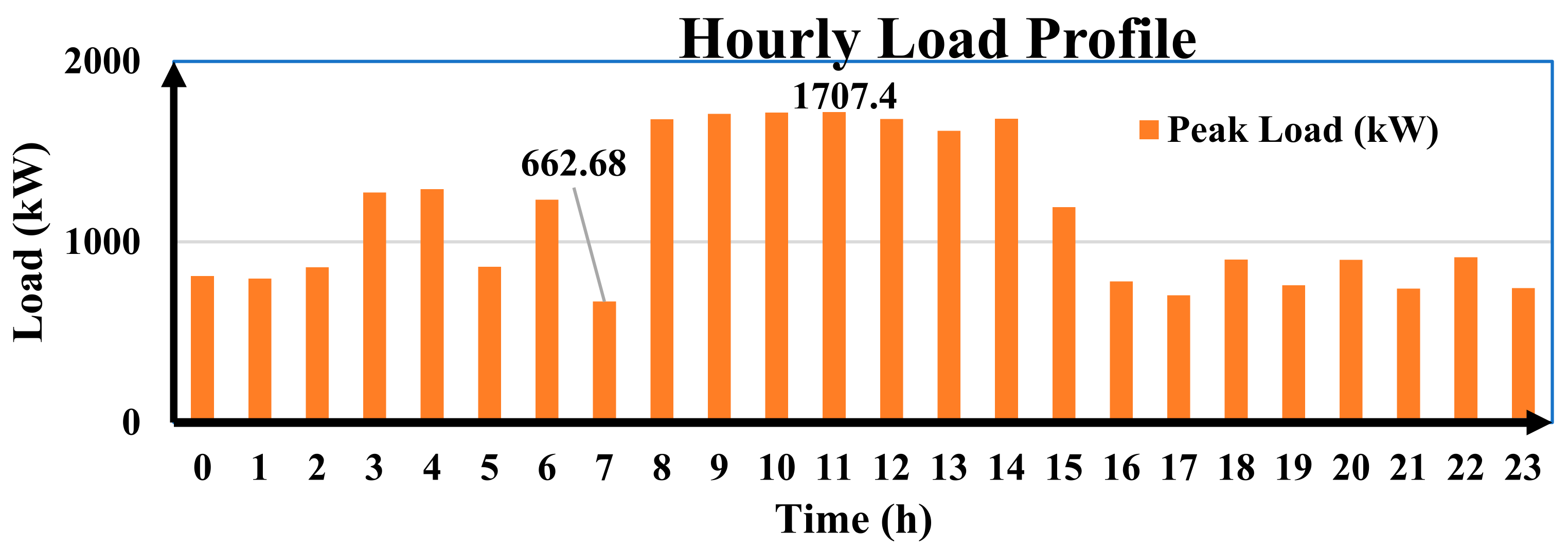
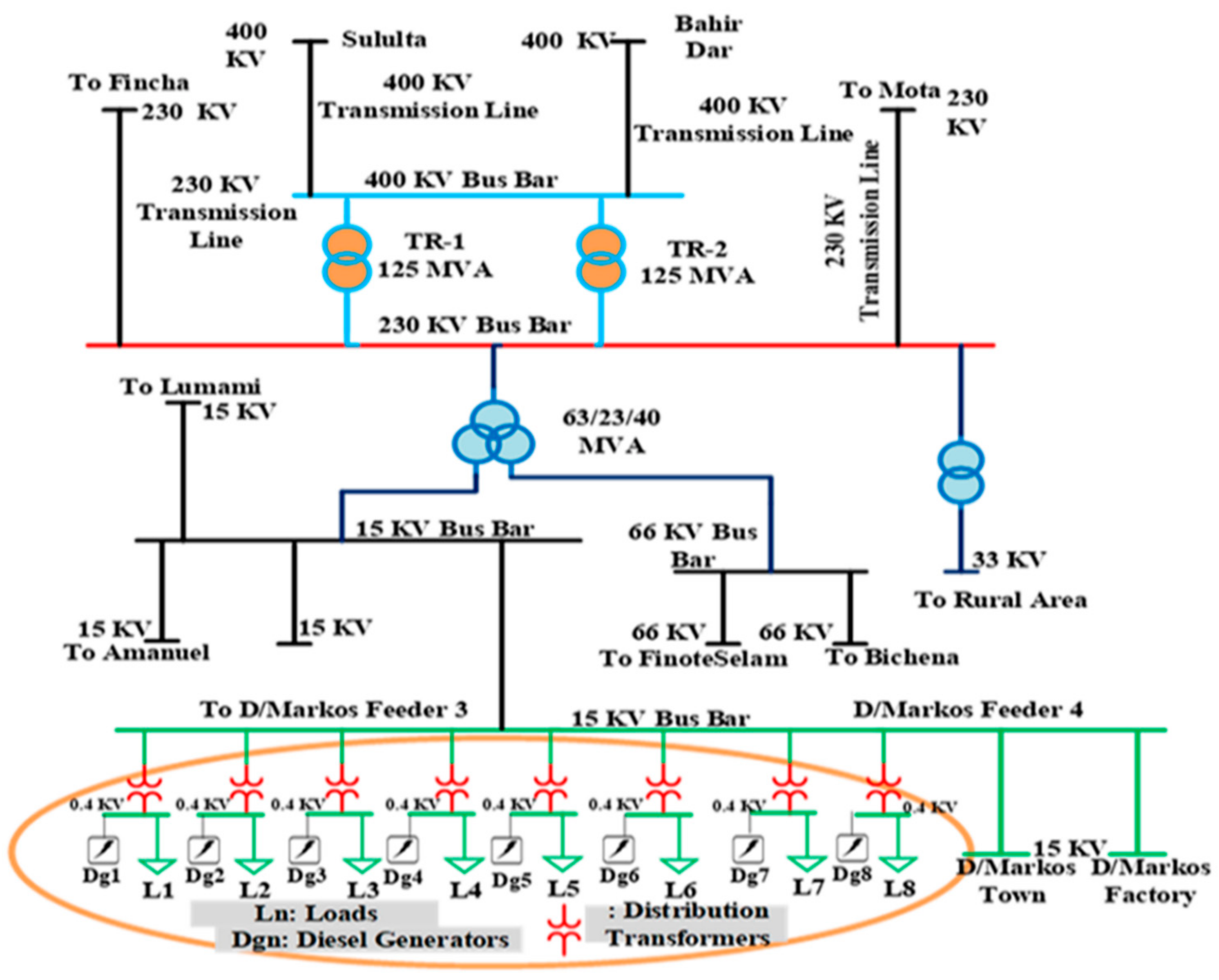
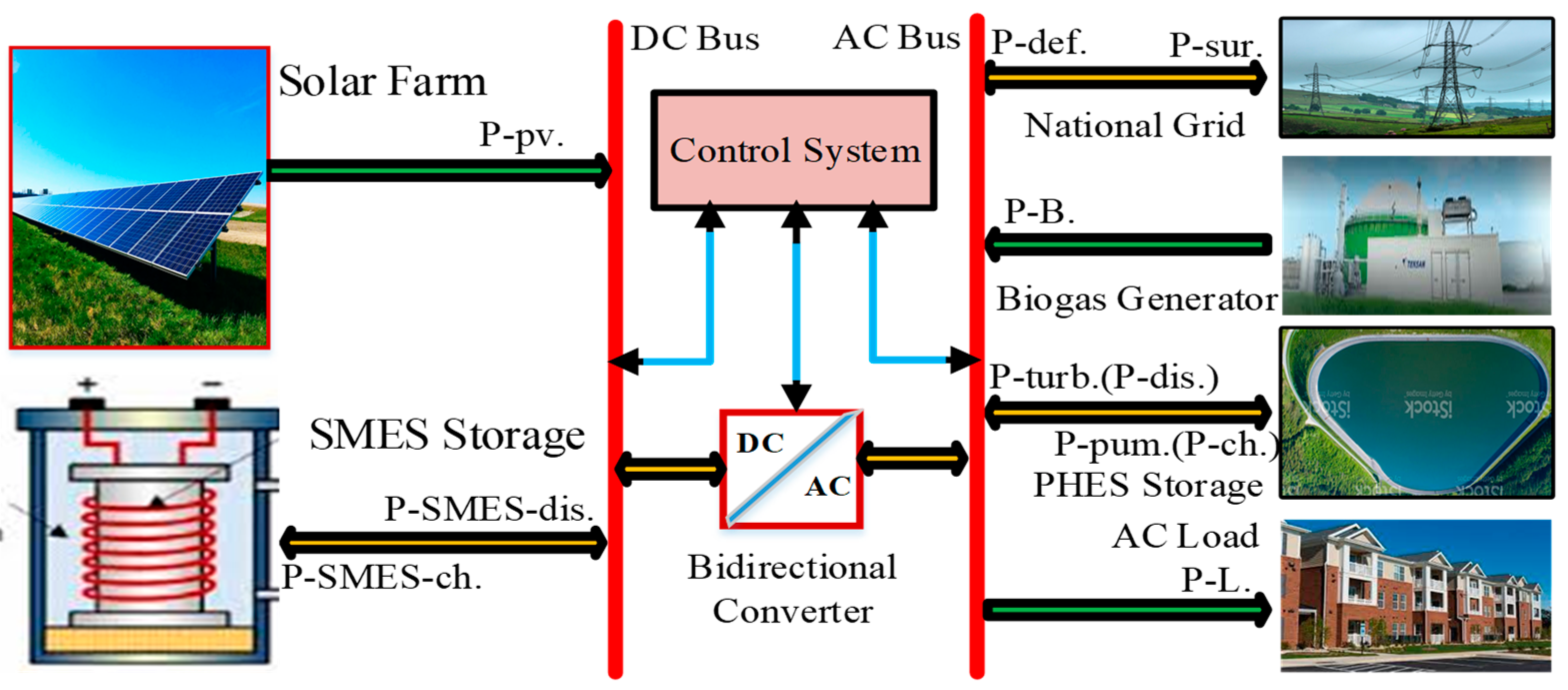
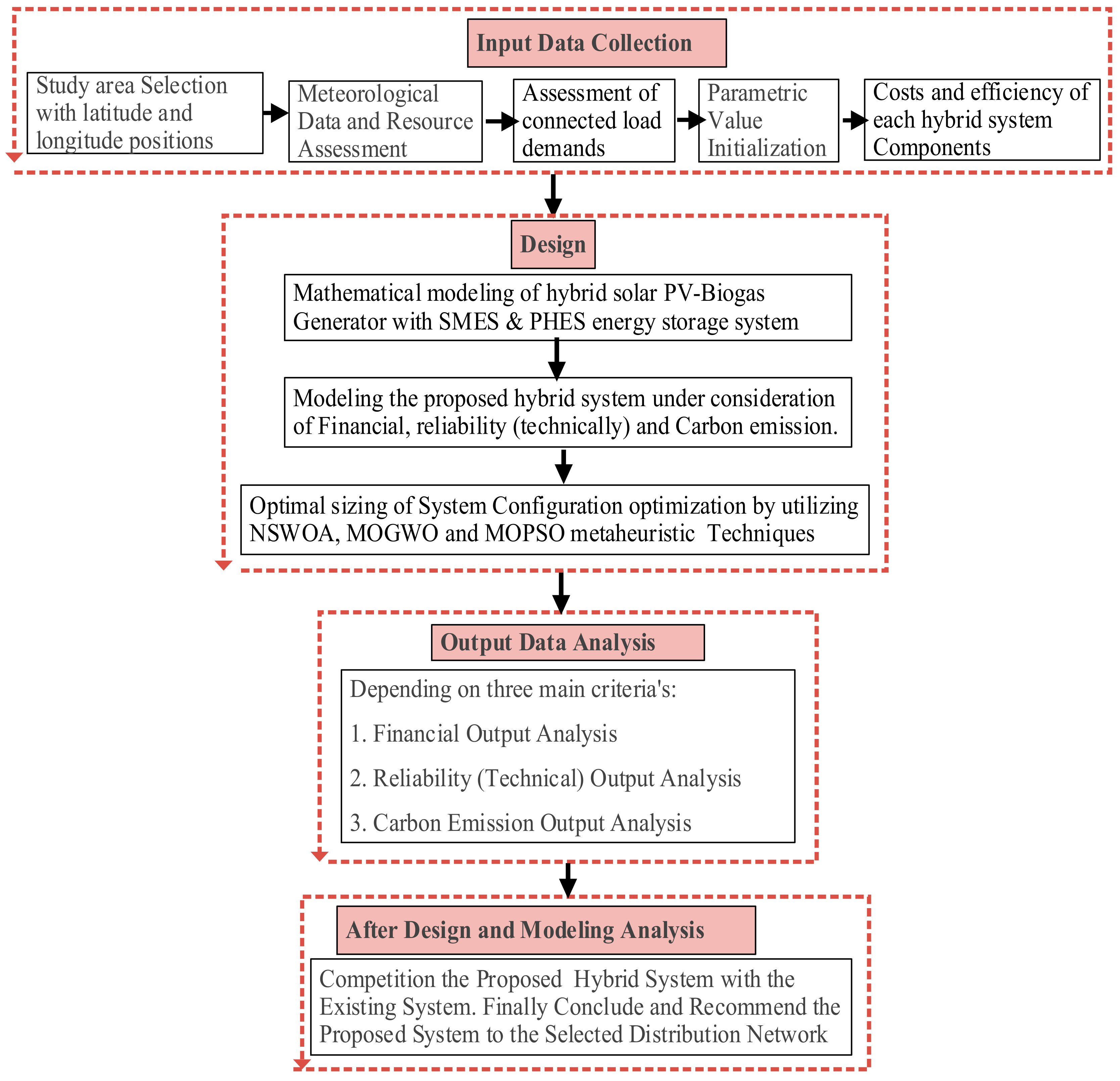
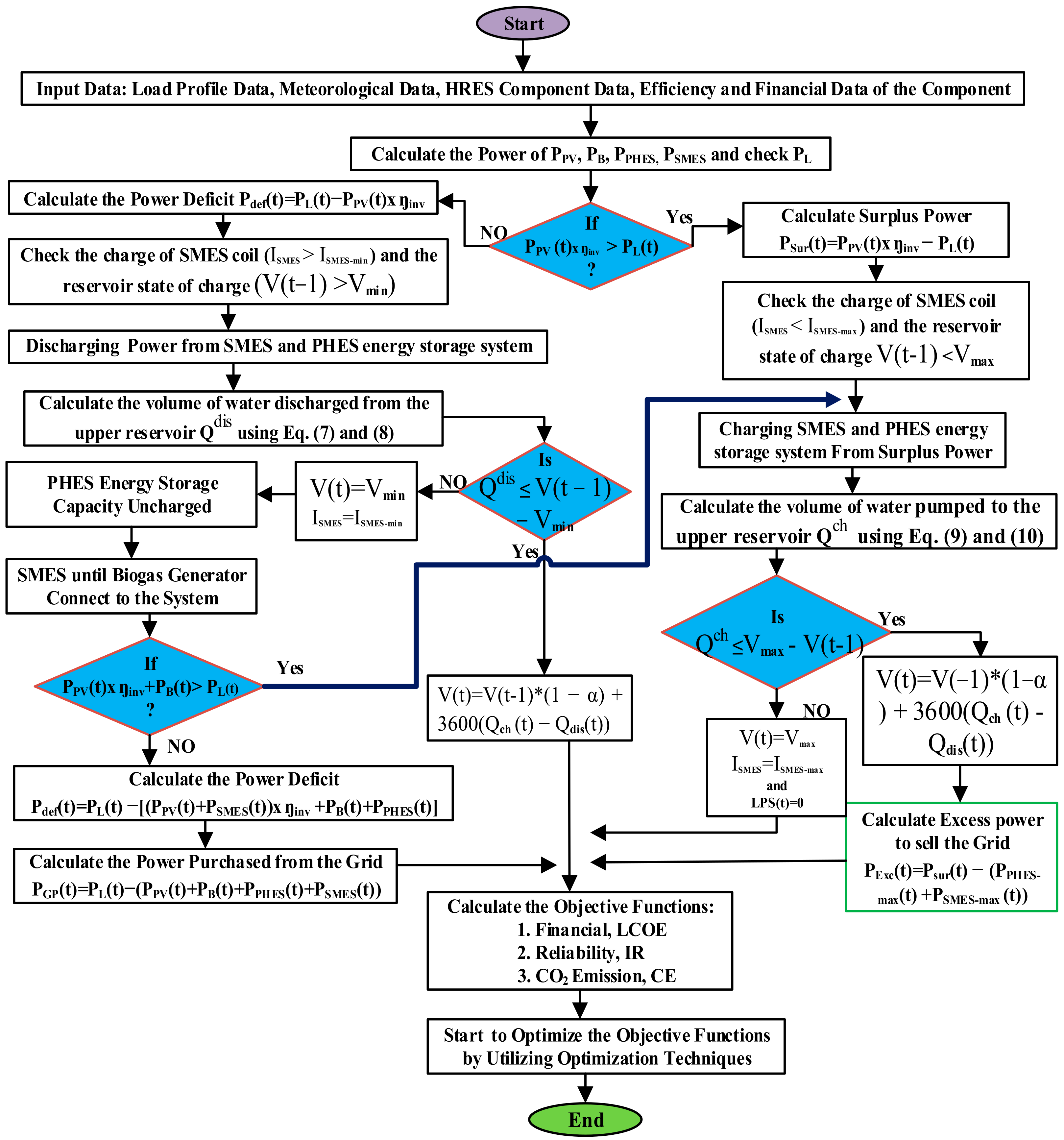
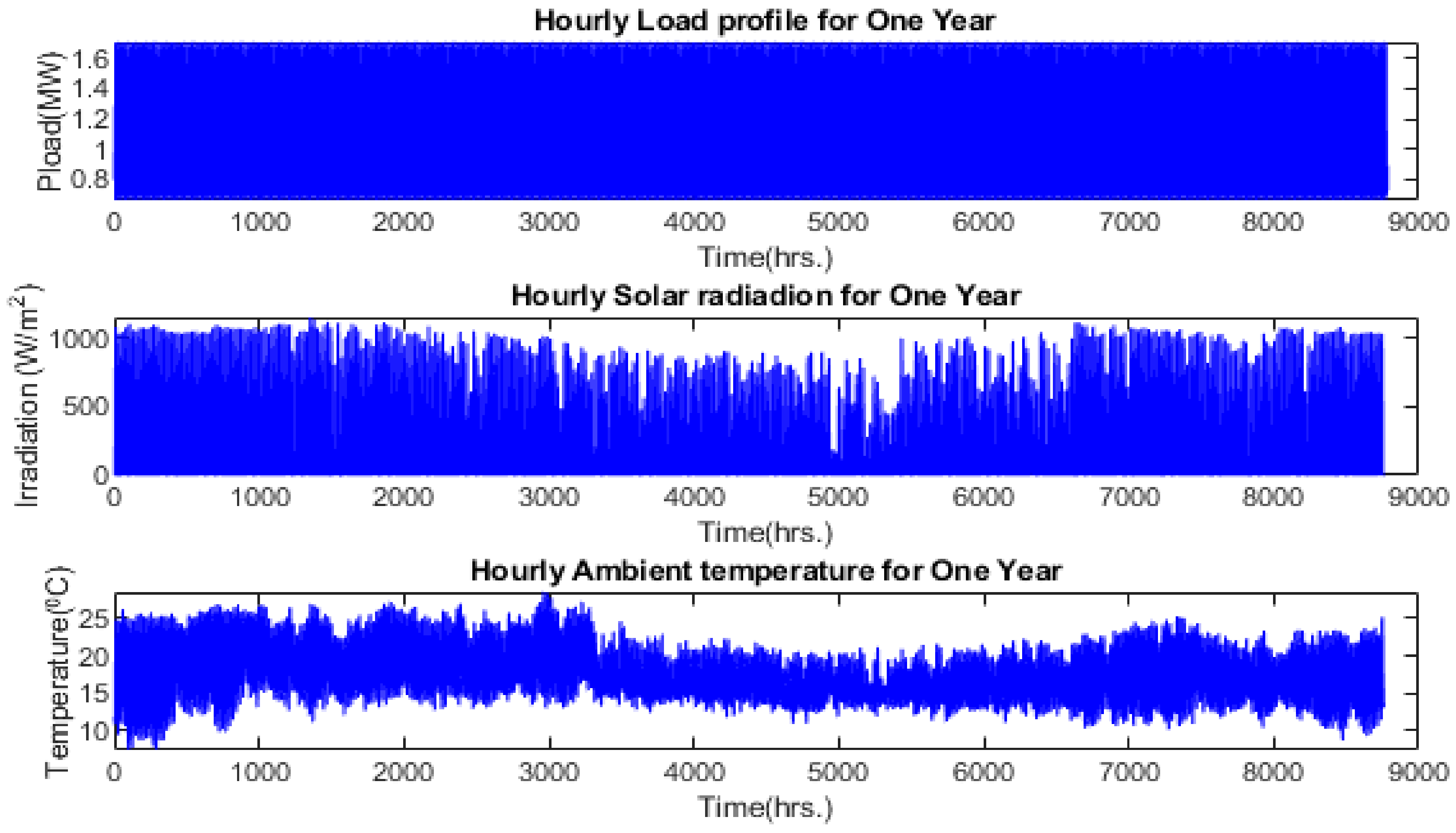
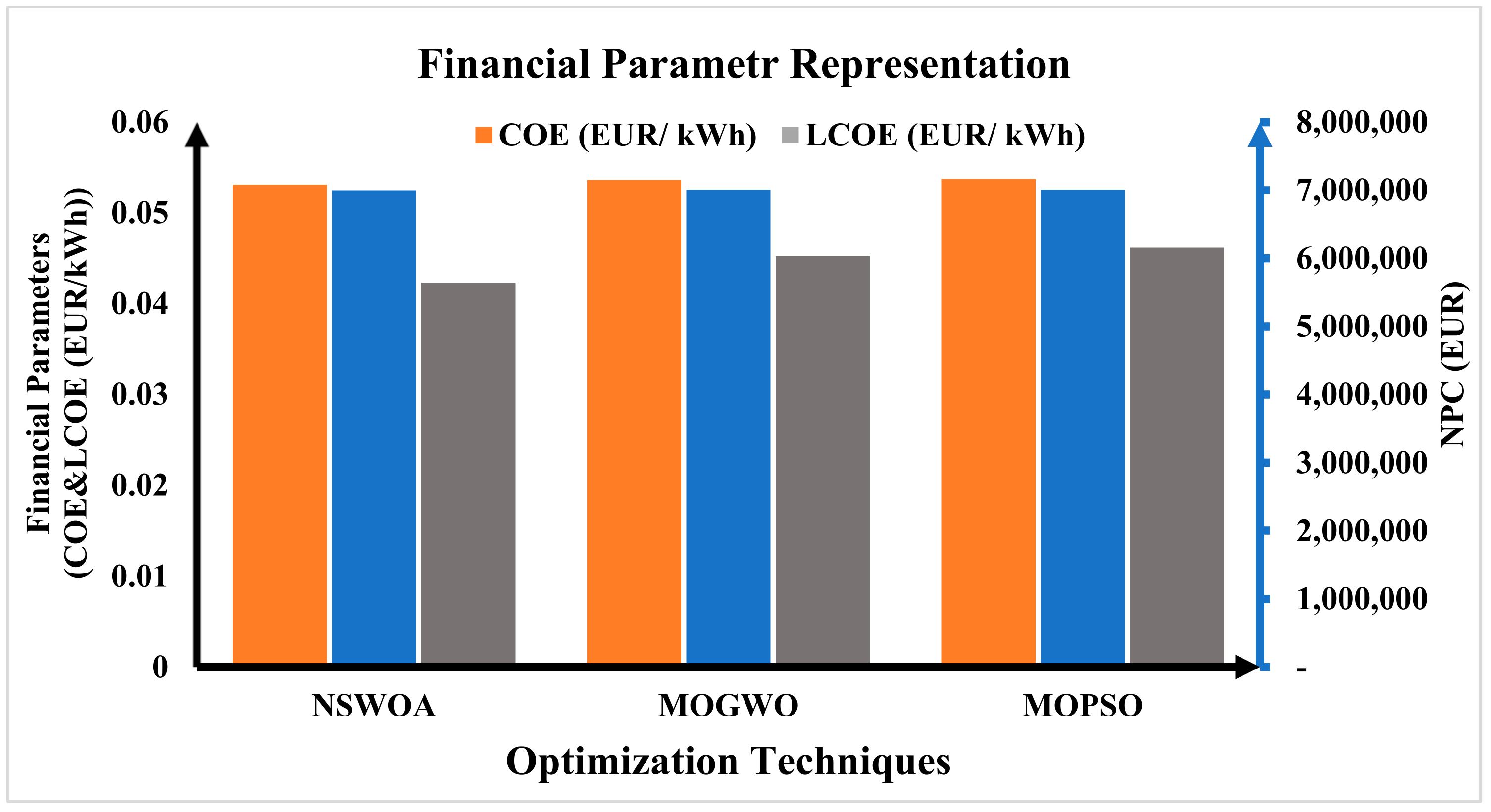
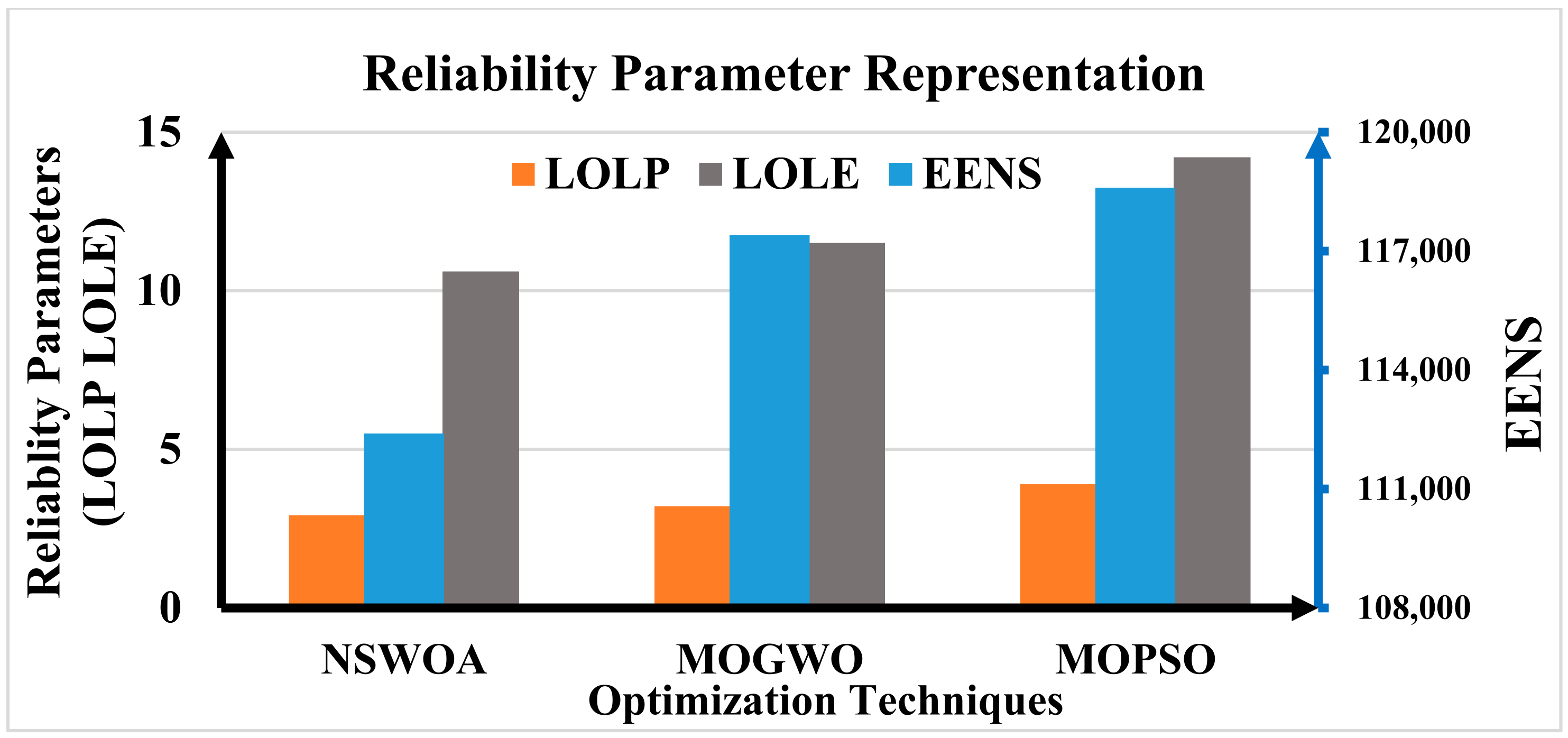
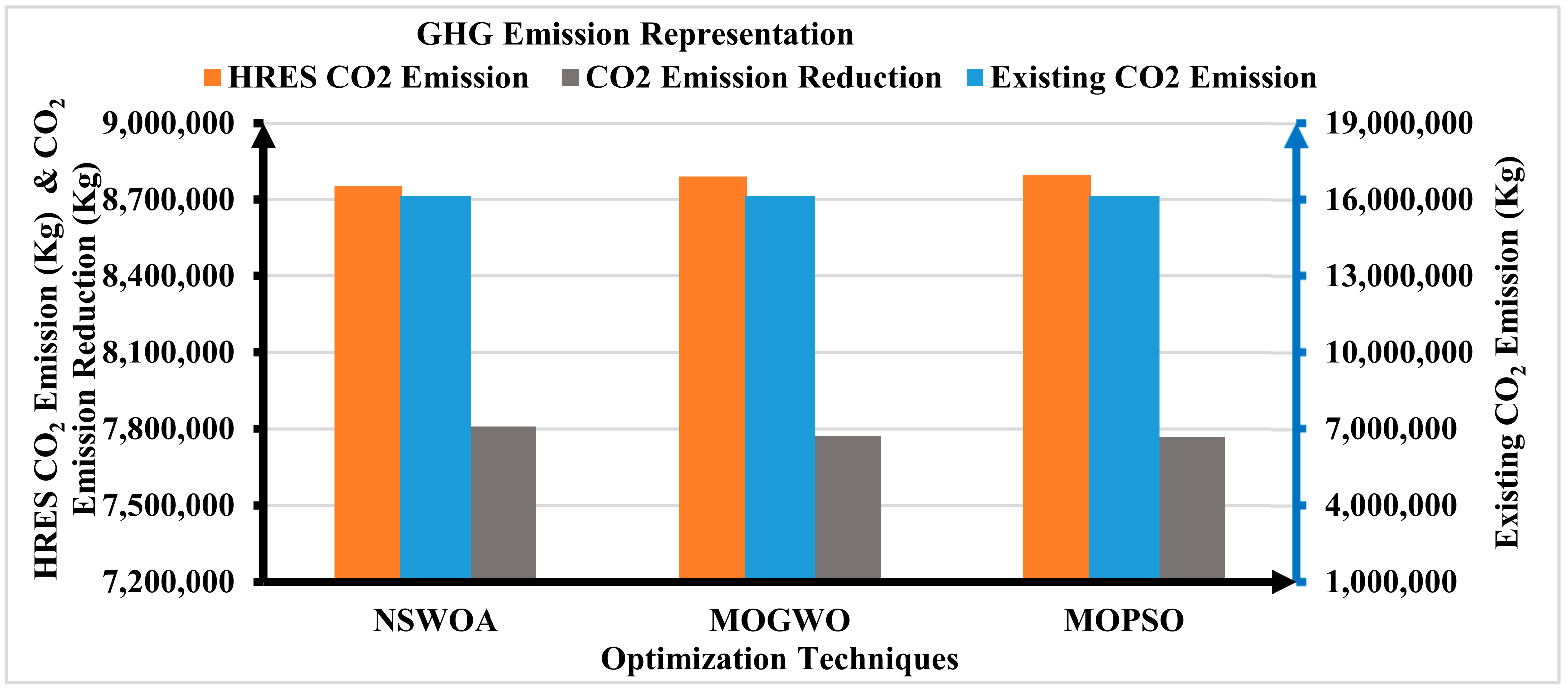

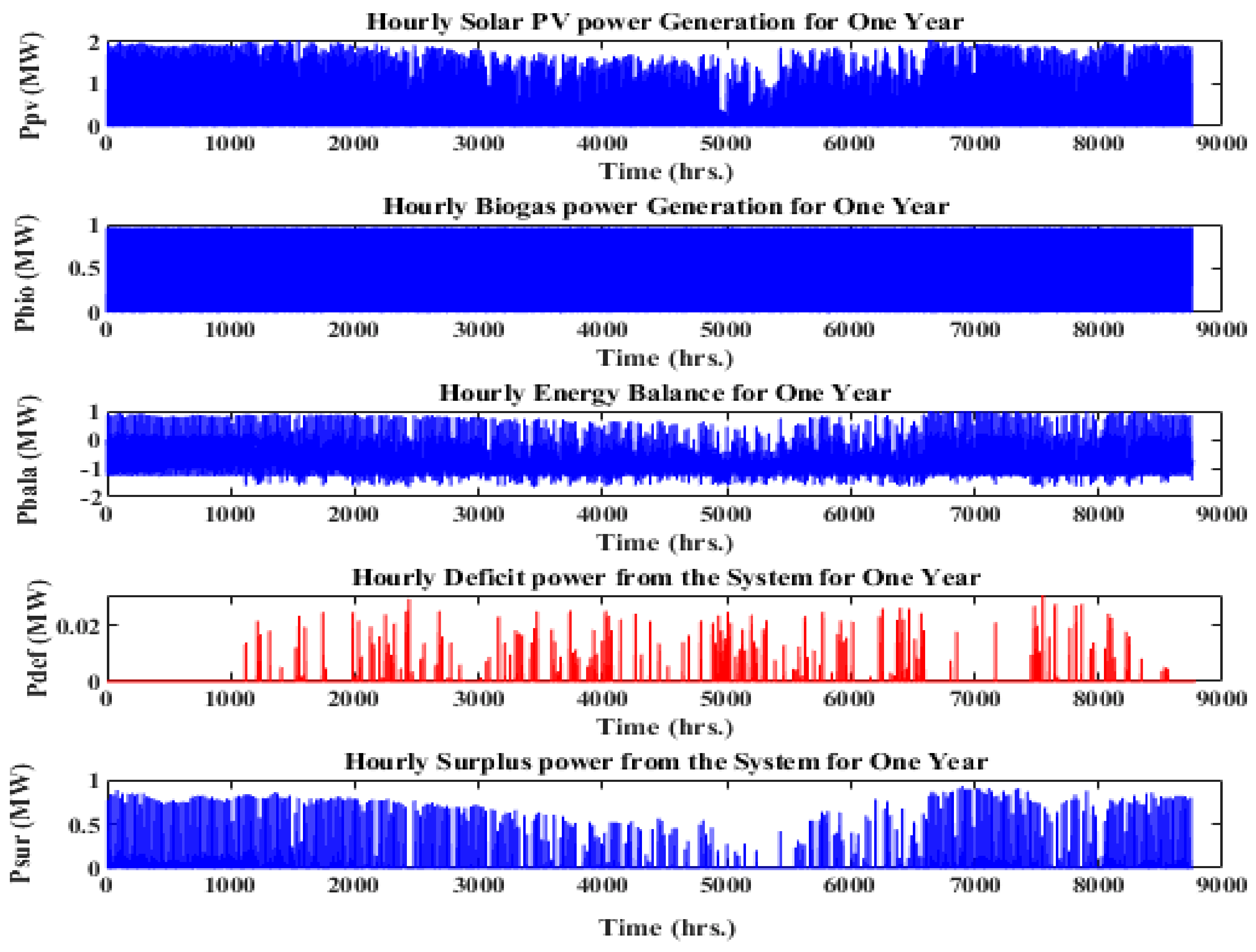

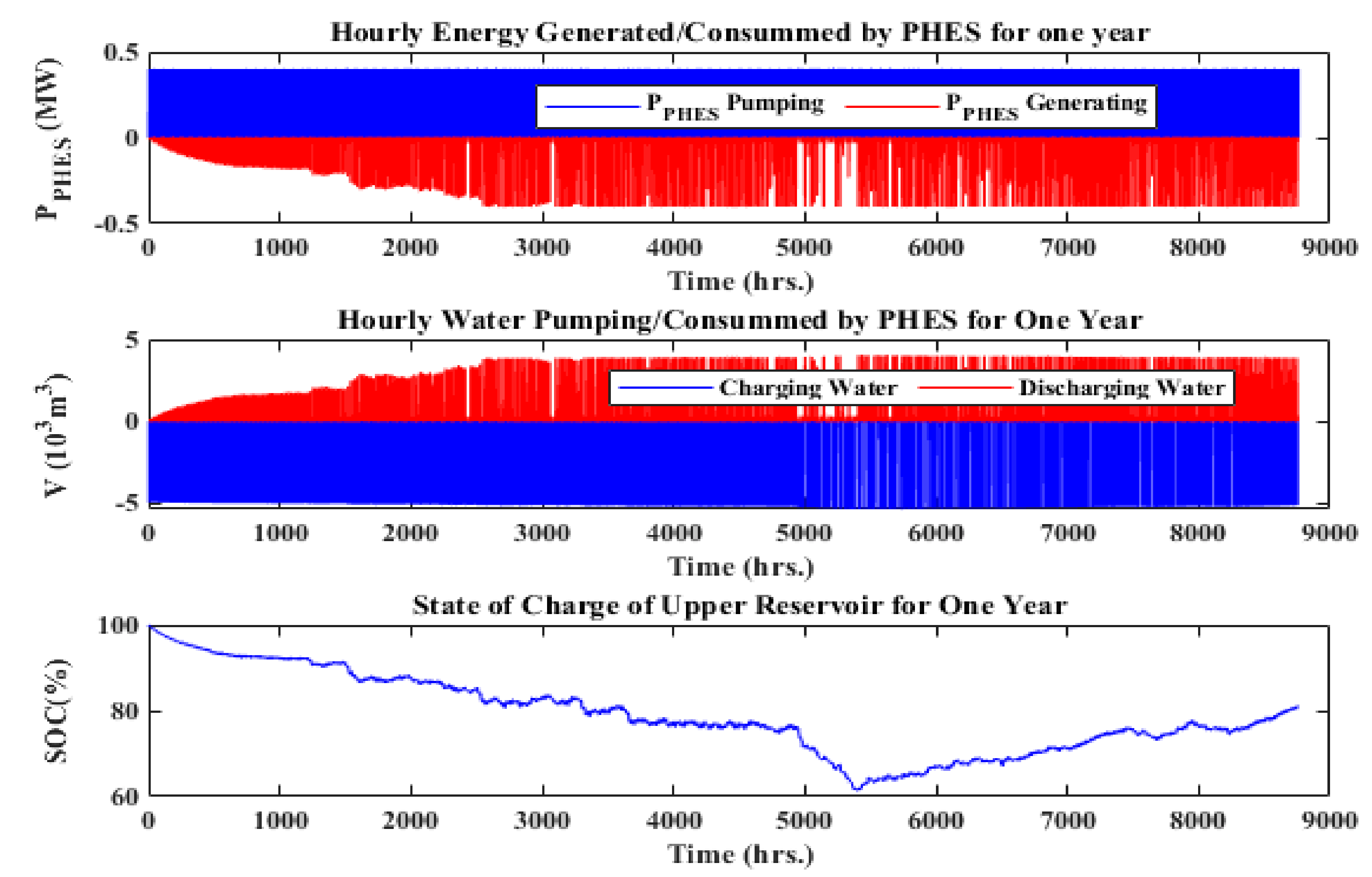
| Solar panel [80] | |
| Max power | 380 Wp |
| Length width | 1.976 × 0.991 m |
| Efficiency | 19.41% |
| Temperature coefficient | 0.41% |
| Initial cost | 145.845 EUR/kW |
| O M cost | 1% of initial cost |
| Life span | 25 years |
| SMES [81] | |
| Energy, ESMES | 1 MJ |
| Inductance, LSMES | 0.5 H |
| Current, ISMES | 1 KA |
| Initial cost | 5000 EUR/kW |
| Voltage, Vdc-link | 2 KV |
| Capacitance, Cdc-link | 0.01 F |
| PHES [82,83] | |
| Overall efficiency | 77% |
| Cost of power conversion | 165–740 EUR/kW |
| Fixe OM cost | 8.5 EUR/kW |
| Variable OM | 0.8 EUR/MWh |
| Life Span | 30 years |
| Biogas generator [84] | |
| Initial cost | 1342.5 EUR/kW |
| Fixed OM cost | 71.65 EUR/kW |
| Variable OM | 20.7 EUR/MWh |
| Inverter [85,86] | |
| Model | UnderstandSolar |
| Initial cost | 172 EUR/kW |
| OM cost | 1% of initial cost |
| Efficiency | 95% |
| Techniques | Type of Renewable Energy Resources | ||||
|---|---|---|---|---|---|
| No of PV Panel | PHES Capacity (KW) | Reservoir Capacity (m3) | Capacity of Biogas (KW) | SMES Capacity (KWh) | |
| NSWOA | 5495.44 | 400.67 | 26,798.14 | 860.29 | 142.28 |
| MOGWO | 5228.58 | 378.97 | 25,296.88 | 936.94 | 142.28 |
| MOPSO | 5464.31 | 362.86 | 24,995.71 | 941.63 | 142.28 |
| Optimization Techniques | NSWOA | MOGWO | MOPSO | |
|---|---|---|---|---|
| Evaluation Parameters | ||||
| NPC (EUR) | 6.997 × 106 | 7.008 × 106 | 7.011 × 106 | |
| Financial | COE (EUR/kWh) | 0.053102 | 0.053625 | 0.053743 |
| LCOE (EUR/kWh) | 0.046218 | 0.046897 | 0.046985 | |
| EENS | 1.124 × 105 | 1.174 × 105 | 1.186 × 105 | |
| LPSP | 0.0085 | 0.0089 | 0.0092 | |
| Reliability | IR | 0.9915 | 0.9911 | 0.9908 |
| LOLP | 2.925 | 3.204 | 3.902 | |
| LOLE | 10.605 | 11.502 | 14.201 | |
| ) | 1.6122 × 107 | 1.6122 × 107 | 1.6122 × 107 | |
| GHG | ) | 8.7536 × 106 | 8.7895 × 106 | 8.7945 × 106 |
| ) | −7.3679 × 106 | −7.3325 × 106 | −7.3275 × 106 |
Disclaimer/Publisher’s Note: The statements, opinions and data contained in all publications are solely those of the individual author(s) and contributor(s) and not of MDPI and/or the editor(s). MDPI and/or the editor(s) disclaim responsibility for any injury to people or property resulting from any ideas, methods, instructions or products referred to in the content. |
© 2023 by the authors. Licensee MDPI, Basel, Switzerland. This article is an open access article distributed under the terms and conditions of the Creative Commons Attribution (CC BY) license (https://creativecommons.org/licenses/by/4.0/).
Share and Cite
Agajie, T.F.; Fopah-Lele, A.; Amoussou, I.; Ali, A.; Khan, B.; Tanyi, E. Optimal Design and Mathematical Modeling of Hybrid Solar PV–Biogas Generator with Energy Storage Power Generation System in Multi-Objective Function Cases. Sustainability 2023, 15, 8264. https://doi.org/10.3390/su15108264
Agajie TF, Fopah-Lele A, Amoussou I, Ali A, Khan B, Tanyi E. Optimal Design and Mathematical Modeling of Hybrid Solar PV–Biogas Generator with Energy Storage Power Generation System in Multi-Objective Function Cases. Sustainability. 2023; 15(10):8264. https://doi.org/10.3390/su15108264
Chicago/Turabian StyleAgajie, Takele Ferede, Armand Fopah-Lele, Isaac Amoussou, Ahmed Ali, Baseem Khan, and Emmanuel Tanyi. 2023. "Optimal Design and Mathematical Modeling of Hybrid Solar PV–Biogas Generator with Energy Storage Power Generation System in Multi-Objective Function Cases" Sustainability 15, no. 10: 8264. https://doi.org/10.3390/su15108264
APA StyleAgajie, T. F., Fopah-Lele, A., Amoussou, I., Ali, A., Khan, B., & Tanyi, E. (2023). Optimal Design and Mathematical Modeling of Hybrid Solar PV–Biogas Generator with Energy Storage Power Generation System in Multi-Objective Function Cases. Sustainability, 15(10), 8264. https://doi.org/10.3390/su15108264









